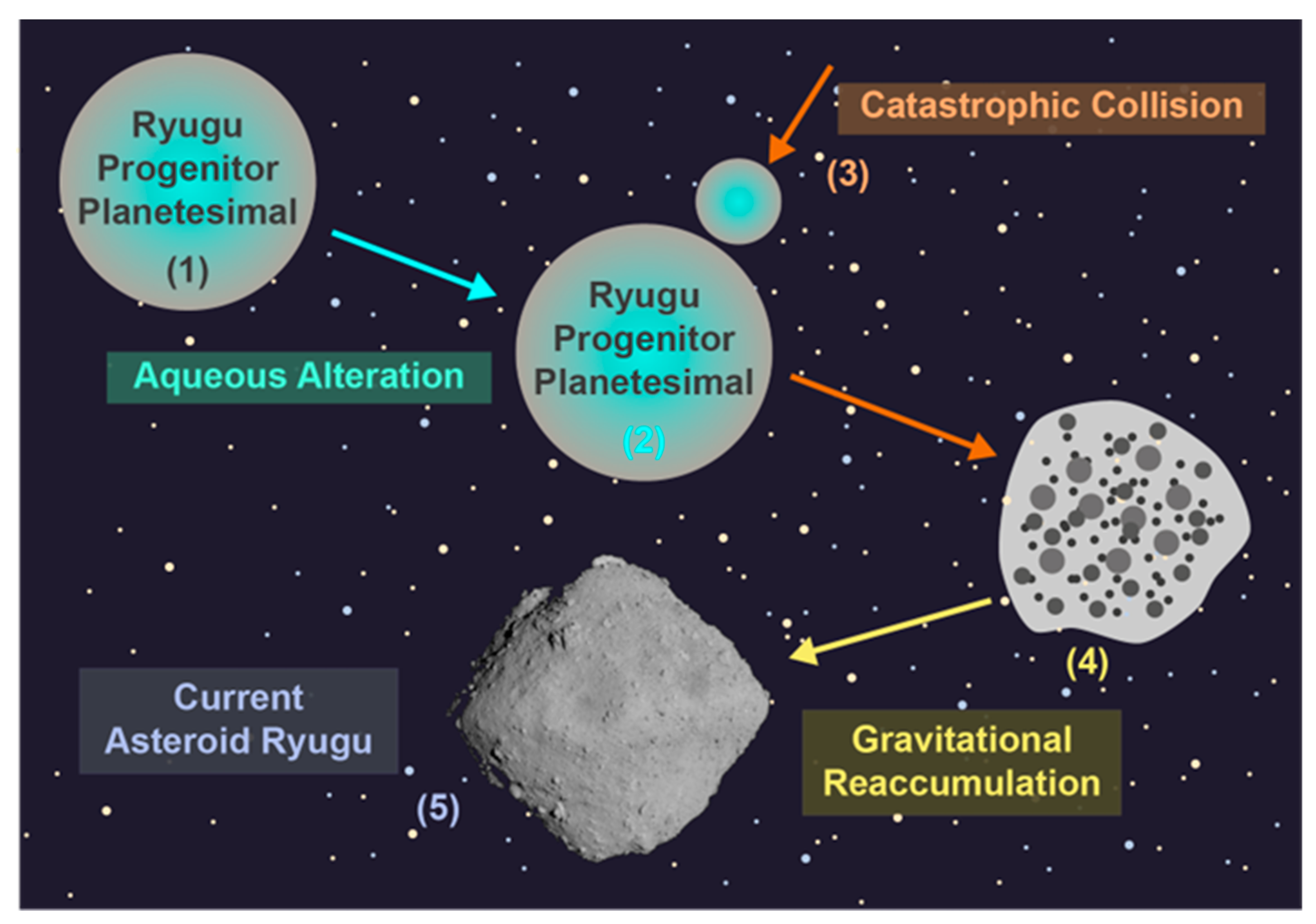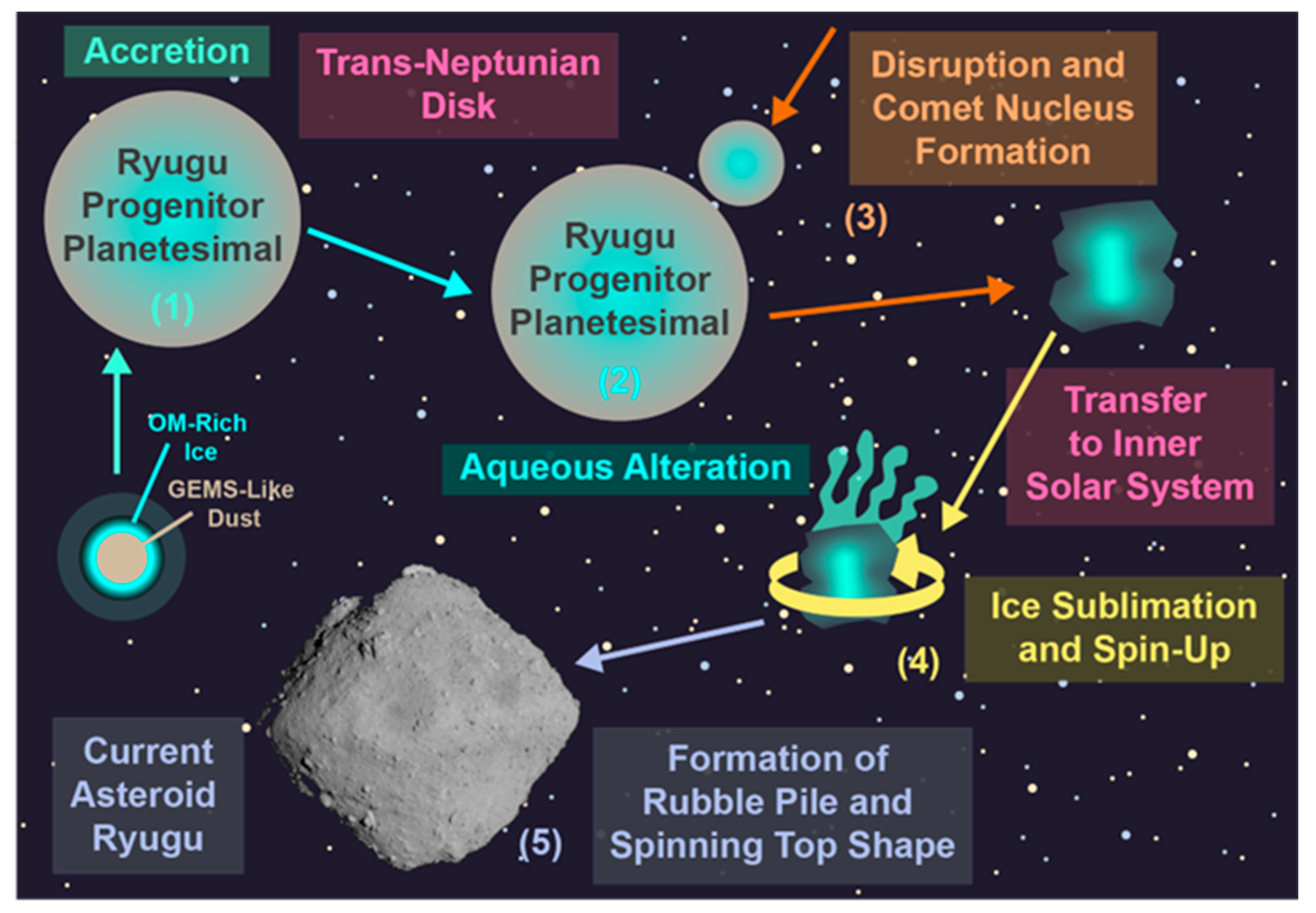
| Version | Summary | Created by | Modification | Content Size | Created at | Operation |
|---|---|---|---|---|---|---|
| 1 | Christian Potiszil | -- | 2129 | 2023-07-18 05:05:39 | | | |
| 2 | Jessie Wu | Meta information modification | 2129 | 2023-07-18 05:20:56 | | |
Video Upload Options
The asteroid 1999 JU3, which would later be named Ryugu, was classified as a Cg-type asteroid in 2001, based on its strong UV absorption feature shortward of 0.55 um and its flat to slightly reddish slope longward of 0.55 um. Cg-type asteroids are part of the C-complex of asteroids, which were suggested to be “primitive” in nature and potentially the parent bodies for carbonaceous chondrites. The linking of carbonaceous chondrites and C-complex asteroids relates to several interpretations concerning features in the near infrared spectra of C-complex asteroids. The features were interpreted as arising from secondary alteration minerals, including goethite, hematite, jarosite and phyllosilicates, that are the products of aqueous alteration and which are found in carbonaceous chondrites.
1. Ryugu (1999 JU3): Remote Sensing Observations and Predictions
2. The Formation and Evolution of Ryugu
2.1. Catastrophic Collsion Model

2.2. Cometary Nucleus Model

References
- Glavin, D.P.; Alexander, C.M.O.; Aponte, J.C.; Dworkin, J.P.; Elsila, J.E.; Yabuta, H. The Origin and Evolution of Organic Matter in Carbonaceous Chondrites and Links to Their Parent Bodies. In Primitive Meteorites and Asteroids; Elsevier: Amsterdam, The Netherlands, 2018; pp. 205–271.
- BINZEL, R.P.; PEROZZI, E.; RIVKIN, A.S.; ROSSI, A.; HARRIS, A.W.; BUS, S.J.; VALSECCHI, G.B.; SLIVAN, S.M. Dynamical and Compositional Assessment of Near-Earth Object Mission Targets. Meteorit. Planet. Sci. 2004, 39, 351–366.
- Tsuda, Y.; Yoshikawa, M.; Abe, M.; Minamino, H.; Nakazawa, S. System Design of the Hayabusa 2—Asteroid Sample Return Mission to 1999 JU3. Acta Astronaut. 2013, 91, 356–362.
- Perna, D.; Barucci, M.A.; Ishiguro, M.; Alvarez-Candal, A.; Kuroda, D.; Yoshikawa, M.; Kim, M.-J.; Fornasier, S.; Hasegawa, S.; Roh, D.-G.; et al. Spectral and Rotational Properties of Near-Earth Asteroid (162173) Ryugu, Target of the Hayabusa2 Sample Return Mission. Astron. Astrophys. 2017, 599, L1.
- Le Corre, L.; Sanchez, J.A.; Reddy, V.; Takir, D.; Cloutis, E.A.; Thirouin, A.; Becker, K.J.; Li, J.-Y.; Sugita, S.; Tatsumi, E. Ground-Based Characterization of Hayabusa2 Mission Target Asteroid 162173 Ryugu: Constraining Mineralogical Composition in Preparation for Spacecraft Operations. Mon. Not. R. Astron. Soc. 2018, 475, 614–623.
- Sugita, S.; Honda, R.; Morota, T.; Kameda, S.; Sawada, H.; Tatsumi, E.; Yamada, M.; Honda, C.; Yokota, Y.; Kouyama, T.; et al. The Geomorphology, Color, and Thermal Properties of Ryugu: Implications for Parent-Body Processes. Science 2019, 364, eaaw0422.
- Flynn, G.J.; Keller, L.P.; Jacobsen, C.; Wirick, S. An Assessment of the Amount and Types of Organic Matter Contributed to the Earth by Interplanetary Dust. Adv. Space Res. 2004, 33, 57–66.
- Vernazza, P.; Marsset, M.; Beck, P.; Binzel, R.P.; Birlan, M.; Brunetto, R.; Demeo, F.E.; Djouadi, Z.; Dumas, C.; Merouane, S.; et al. Interplanetary dust particles as samples of icy asteroids. Astrophys. J. 2015, 806, 204.
- Potiszil, C.; Tanaka, R.; Kobayashi, K.; Kunihiro, T.; Nakamura, E. The Albedo of Ryugu: Evidence for a High Organic Abundance, as Inferred from the Hayabusa2 Touchdown Maneuver. Astrobiology 2020, 20, 916–921.
- Wirick, S.; Flynn, G.J.; Keller, L.P.; Nakamura-Messenger, K.; Peltzer, C.; Jacobsen, C.; Sandford, S.; Zolensky, M. Organic Matter from Comet 81P/Wild 2, IDPs, and Carbonaceous Meteorites; Similarities and Differences. Meteorit. Planet. Sci. 2009, 44, 1611–1626.
- Busemann, H.; Nguyen, A.N.; Cody, G.D.; Hoppe, P.; Kilcoyne, A.L.D.; Stroud, R.M.; Zega, T.J.; Nittler, L.R. Ultra-Primitive Interplanetary Dust Particles from the Comet 26P/Grigg–Skjellerup Dust Stream Collection. Earth Planet. Sci. Lett. 2009, 288, 44–57.
- Watanabe, S.; Hirabayashi, M.; Hirata, N.; Hirata, N.; Noguchi, R.; Shimaki, Y.; Ikeda, H.; Tatsumi, E.; Yoshikawa, M.; Kikuchi, S.; et al. Hayabusa2 Arrives at the Carbonaceous Asteroid 162173 Ryugu—A Spinning Top-Shaped Rubble Pile. Science 2019, 364, 268–272.
- Michel, P.; Ballouz, R.L.; Barnouin, O.S.; Jutzi, M.; Walsh, K.J.; May, B.H.; Manzoni, C.; Richardson, D.C.; Schwartz, S.R.; Sugita, S.; et al. Collisional Formation of Top-Shaped Asteroids and Implications for the Origins of Ryugu and Bennu. Nat. Commun. 2020, 11, 2655.
- Nakamura, E.; Kobayashi, K.; Tanaka, R.; Kunihiro, T.; Kitagawa, H.; Potiszil, C.; Ota, T.; Sakaguchi, C.; Yamanaka, M.; Ratnayake, D.M.; et al. On the Origin and Evolution of the Asteroid Ryugu: A Comprehensive Geochemical Perspective. Proc. Jpn. Acad. Ser. B 2022, 98, 227–282.
- Potiszil, C.; Ota, T.; Yamanaka, M.; Sakaguchi, C.; Kobayashi, K.; Tanaka, R.; Kunihiro, T.; Kitagawa, H.; Abe, M.; Miyazaki, A.; et al. Insights into the Formation and Evolution of Extraterrestrial Amino Acids from the Asteroid Ryugu. Nat. Commun. 2023, 14, 1482.
- Naraoka, H.; Takano, Y.; Dworkin, J.P.; Oba, Y.; Hamase, K.; Furusho, A.; Ogawa, N.O.; Hashiguchi, M.; Fukushima, K.; Aoki, D.; et al. Soluble Organic Molecules in Samples of the Carbonaceous Asteroid (162173) Ryugu. Science 2023, 379, eabn9033.
- Parker, E.T.; McLain, H.L.; Glavin, D.P.; Dworkin, J.P.; Elsila, J.E.; Aponte, J.C.; Naraoka, H.; Takano, Y.; Tachibana, S.; Yabuta, H.; et al. Extraterrestrial Amino Acids and Amines Identified in Asteroid Ryugu Samples Returned by the Hayabusa2 Mission. Geochim. Cosmochim. Acta 2023, 347, 42–57.
- Oba, Y.; Koga, T.; Takano, Y.; Ogawa, N.O.; Ohkouchi, N.; Sasaki, K.; Sato, H.; Glavin, D.P.; Dworkin, J.P.; Naraoka, H.; et al. Uracil in the Carbonaceous Asteroid (162173) Ryugu. Nat. Commun. 2023, 14, 1292.
- Yabuta, H.; Cody, G.D.; Engrand, C.; Kebukawa, Y.; De Gregorio, B.; Bonal, L.; Remusat, L.; Stroud, R.; Quirico, E.; Nittler, L.; et al. Macromolecular Organic Matter in Samples of the Asteroid (162173) Ryugu. Science 2023, 379, 25.
- Nakamura, T.; Matsumoto, M.; Amano, K.; Enokido, Y.; Zolensky, M.E.; Mikouchi, T.; Genda, H.; Tanaka, S.; Zolotov, M.Y.; Kurosawa, K.; et al. Formation and Evolution of Carbonaceous Asteroid Ryugu: Direct Evidence from Returned Samples. Science 2022, 379, eabn8671.
- Young, E.D.; Zhang, K.K.; Schubert, G. Conditions for Pore Water Convection within Carbonaceous Chondrite Parent Bodies—Implications for Planetesimal Size and Heat Production. Earth Planet. Sci. Lett. 2003, 213, 249–259.
- TRAVIS, B.; SCHUBERT, G. Hydrothermal Convection in Carbonaceous Chondrite Parent Bodies. Earth Planet. Sci. Lett. 2005, 240, 234–250.
- Alexander, C.M.O. Quantitative Models for the Elemental and Isotopic Fractionations in Chondrites: The Carbonaceous Chondrites. Geochim. Cosmochim. Acta 2019, 254, 277–309.
- Prialnik, D.; Podolak, M. Radioactive Heating of Porous Comet Nuclei. Icarus 1995, 117, 420–430.
- Miura, H.; Nakamura, E.; Kunihiro, T. The Asteroid 162173 Ryugu: A Cometary Origin. Astrophys. J. Lett. 2022, 925, L15.
- Ota, T.; Potiszil, C.; Kobayashi, K.; Tanaka, R.; Kitagawa, H.; Kunihiro, T.; Sakaguchi, C.; Yamanaka, M.; Nakamura, E. The Formation of a Rubble Pile Asteroid: Insights from the Asteroid Ryugu. Universe 2023, 9, 293.
- Gounelle, M.; Zolensky, M.E. The Orgueil Meteorite: 150 Years of History. Meteorit. Planet. Sci. 2014, 49, 1769–1794.
- Gounelle, M.; Morbidelli, A.; Bland, P.A.; Young, E.D.; Sephton, M. Meteorites from the Outer Solar System? In The Solar System beyond Neptune; Barucci, M.A., Boehnhardt, H., Cruikshank, D.P., Morbidelli, A., Eds.; University of Arizona Press: Tucson, AZ, USA, 2008; pp. 525–541. ISBN 9780816527557.
- Dones, L.; Brasser, R.; Kaib, N.; Rickman, H. Origin and Evolution of the Cometary Reservoirs. Space Sci. Rev. 2015, 197, 191–269.
- Morbidelli, A.; Rickman, H. Comets as Collisional Fragments of a Primordial Planetesimal Disk. Astron. Astrophys. 2015, 583, A43.
- Schwartz, S.R.; Michel, P.; Jutzi, M.; Marchi, S.; Zhang, Y.; Richardson, D.C. Catastrophic Disruptions as the Origin of Bilobate Comets. Nat. Astron. 2018, 2, 379–382.
- Jutzi, M.; Benz, W. Formation of Bi-Lobed Shapes by Sub-Catastrophic Collisions. Astron. Astrophys. 2017, 597, A62.
- Morbidelli, A.; Nesvorný, D. Kuiper Belt: Formation and Evolution. In The Trans-Neptunian Solar System; Elsevier: Amsterdam, The Netherlands, 2020; pp. 25–59.
- Gomes, R.; Levison, H.F.; Tsiganis, K.; Morbidelli, A. Origin of the Cataclysmic Late Heavy Bombardment Period of the Terrestrial Planets. Nature 2005, 435, 466–469.
- Tsiganis, K.; Gomes, R.; Morbidelli, A.; Levison, H.F. Origin of the Orbital Architecture of the Giant Planets of the Solar System. Nature 2005, 435, 459–461.
- Nesvorný, D.; Morbidelli, A. Statistical study of the early solar system’s instability with four, five, and six giant planets. Astron. J. 2012, 144, 117.
- Hasegawa, S.; Marsset, M.; DeMeo, F.E.; Bus, S.J.; Geem, J.; Ishiguro, M.; Im, M.; Kuroda, D.; Vernazza, P. Discovery of Two TNO-like Bodies in the Asteroid Belt. Astrophys. J. Lett. 2021, 916, L6.
- Raymond, S.N.; Izidoro, A. The Empty Primordial Asteroid Belt. Sci. Adv. 2017, 3, e1701138.
- Nuth, J.A.; Abreu, N.; Ferguson, F.T.; Glavin, D.P.; Hergenrother, C.; Hill, H.G.M.; Johnson, N.M.; Pajola, M.; Walsh, K. Volatile-Rich Asteroids in the Inner Solar System. Planet. Sci. J. 2020, 1, 82.
- Tripathi, H.; Potiszil, C.; Tanaka, R.; Nakamura, E. The Ice-Organic-Silicate Contents of Small Solar System Bodies: Indicators for a Comet to Asteroid Evolutionary Pathway. Mon. Not. R. Astron. Soc. 2022, 513, 3734–3741.
- Davidsson, B.J.R.; Sierks, H.; Güttler, C.; Marzari, F.; Pajola, M.; Rickman, H.; A’Hearn, M.F.; Auger, A.-T.; El-Maarry, M.R.; Fornasier, S.; et al. The Primordial Nucleus of Comet 67P/Churyumov-Gerasimenko. Astron. Astrophys. 2016, 592, A63.
- Fornasier, S.; Hoang, V.H.; Hasselmann, P.H.; Feller, C.; Barucci, M.A.; Deshapriya, J.D.P.; Sierks, H.; Naletto, G.; Lamy, P.L.; Rodrigo, R.; et al. Linking Surface Morphology, Composition, and Activity on the Nucleus of 67P/Churyumov-Gerasimenko. Astron. Astrophys. 2019, 630, A7.
- Bruck Syal, M.; Schultz, P.H.; Sunshine, J.M.; A’Hearn, M.F.; Farnham, T.L.; Dearborn, D.S.P. Geologic Control of Jet Formation on Comet 103P/Hartley 2. Icarus 2013, 222, 610–624.
- Ehrenfreund, P.; Glavin, D.P.; Botta, O.; Cooper, G.; Bada, J.L. Extraterrestrial Amino Acids in Orgueil and Ivuna: Tracing the Parent Body of CI Type Carbonaceous Chondrites. Proc. Natl. Acad. Sci. USA 2001, 98, 2138–2141.




